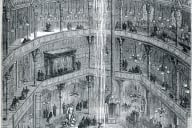You have /5 articles left.
Sign up for a free account or log in.
Two years ago, The Virginia Quarterly Review published an essay called "Quarterlies and the Future of Reading." The author, George Core, has been the editor of The Sewanee Review since 1973 -- at which time, it was already a venerable institution, one of the oldest publications of its kind in the United States.
By "publications of its kind," I mean the general-interest cultural quarterlies, usually published by universities or liberal-arts colleges. Unlike scholarly journals, they aren't focused on a particular field. Usually they offer a mixture of contemporary poetry and fiction with essays that are learned but nonspecialist.
It pays to be explicit about that, because so few people keep track of the university quarterlies now. Many of them are still around, with a modest if reliable subscriber base in the libraries. But it often seems as if they continue just by inertia.
It is always a sentimental gesture to speak of a golden age. But what the hell: The years between, say, 1925 and 1965 were a glorious time for such journals. Then, as now, their circulations were usually modest. But the worlds of publishing and of the university were smaller, and the quarterlies had a disproportionately large role to play. Truman Capote once mentioned in an interview how he knew he had "arrived" as a young writer in the 1940s: On the same day, he received two or three letters from the editors of quarterlies accepting his short stories for publication in their pages.
In his essay, two years ago, Core insisted that "the literary quarterly ... has been the linchpin of civilization since the 18th century." And if things did not look encouraging at the dawn of the 21st century ... well, so much the worse for what that says about civilization. "The average librarian these days, like many members of various departments in the humanities," wrote Core, "has become hostile to books and hostile to reading." Needless to say, technology is to blame.
It is hard to know what to make of the fact that Core's essay is now available online. I mean, sure, you can read it that way, but would he really want that?
But cantankerousness in defense of the quarterly is no vice. Nor, for that matter, is it a virtue to overstate how much the university-based general-interest periodical has declined. The situation may not be good, but it is not quite catastrophic.
Core's Sewanee Review is hopelessly out of touch with many trends in contemporary literary studies -- which is one reason it is still worth reading. But The Minnesota Review is very much in touch with developments in cultural theory, while also publishing a good deal of poetry, fiction, and personal essays. I've been reading it with interest for 25 years now (during which time it has never actually been published or edited in Minnesota). The Common Review, published by the Great Books Foundation, occupies a niche somewhere between the old-fashioned university quarterly and magazines such as Harper's and The Atlantic Monthly.
The list could go on -- and if it did, would have to include such non-academic, sui generis publications as N+1, which I've been urging upon the attention of startled bystanders ever since seeing the prototype pamphlet that appeared in advance of its debut, not quite two years ago. A third issue is now at newsstands. (See also the magazine's Web site. )
And if you want to see some interesting and successful experiments in updating the whole format, keep an eye out for Boston Review and The Virginia Quarterly Review.
The September/October issue of Boston Review marks its 30th anniversary. Coming out six times a year, and as a tabloid, BR might at first seem to bear little resemblance to the university quarterlies of any era. But those differences are superficial. The mixture of political, philosophical, and literarydiscussion calls to mind the early Partisan Review, the most agenda-setting of the quarterlies published at mid-century.
Boston Review's anniversary issue contains a 12-page anthology of poems and essay organized by year -- including work by (to give a partial list) John Kenneth Galbraith, Adrienne Rich, Rita Dove, Ralph Nader, George Scialabba, and Martha Nussbaum. (Somebody on that list is bound to interest or agitate you.) One of the selections for 1993 comes from an essay by Christopher Hitchens called "Never Trust Imperialists." It would have been interesting to hear the editorial discussion that resulted in that one being included.
As for The Virginia Quarterly Review, it has come under a new editor, Ted Genoways, who seems to have ignored entirely the worries expressed in George Core's ruminations on the state of the quarterly. In its new incarnation, [ital]VQR[ital] is colorful, topical, even a bit flashy -- with the latest issue offering a gallery of photographs from Vietnam as well as a pull-out comic book by Art Spiegelman, along with poetry, fiction, a play, and several essays.
Some of the once-vital quarterlies ended up becoming so polite and reserved that their audiences did not so much read them as search each issue for signs of a pulse. You certainly don't have that problem with Boston Review or VQR. Recent discussion of standards for "public scholarship" has emphasized the possibility of creating venues "at the interface of campus and community."
Arguably, that is what the quarterlies and review always were -- and their revitalization now can only be a good sign.




